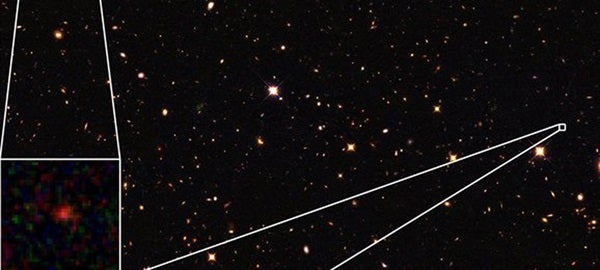“Today, the universe is old and filled with galaxies that have largely stopped forming stars, a sign of galactic maturity,” said Caroline Straatman from the Leiden University in the Netherlands. “However, in the distant past, galaxies were still actively growing by consuming gas and turning it into stars. This means that mature galaxies are expected to be almost non-existent when the universe was still young.”
Astronomers used sensitive images at near infrared wavelengths to search for galaxies in the early universe with red colors. The characteristic red colors indicate the presence of old stars and a lack of active star formation. Surprisingly, they located 15 galaxies at an average distance of 12 billion light-years, only 1.6 billion years after the Big Bang. The galaxies are barely detectable at visual wavelengths and are easily overlooked, but in the new near-infrared light, images are easily seen. The team estimates they already contained as many as 100 billion stars on average per galaxy.
The mature galaxies have masses similar to that of the Milky Way but were already retired from star formation when the universe was only 12 percent of its current age. While the Milky Way currently forms new stars at a slow rate, these galaxies must have formed rapidly in a short time (roughly 1 billion years), with explosive events in which new stars were being formed. This must have happened at rates several hundred times higher than in the Milky Way today.
“This finding raises new questions,” said team leader Ivo Labbe from Leiden University. “For example, about how these galaxies formed so rapidly and why they stopped forming stars so early? It is an enigma that these galaxies seem to come out of nowhere. Large numbers of galaxies with explosive rates of star formation have not yet been identified in the early universe. Another big question is what caused the galaxies to mature at such a young age and if some dramatic event might have caused this.”
The galaxies were discovered after 40 nights of observing with the FourStar camera on the Magellan Baade Telescope in Chile and combined with data from Hubble’s Cosmic Assembly Near-infrared Deep Extragalactic Legacy Survey and the Great Observatories Origins Deep Survey. Using special filters to produce images that are sensitive to narrow slices of the near infrared spectrum, the team was able to measure accurate distances to thousands of distant galaxies at a time, providing a 3-D map of the early universe.










